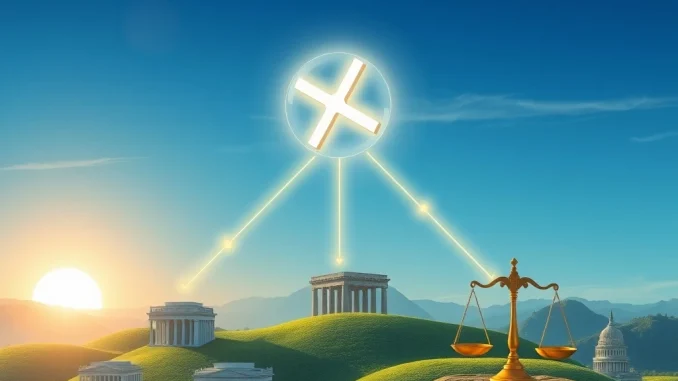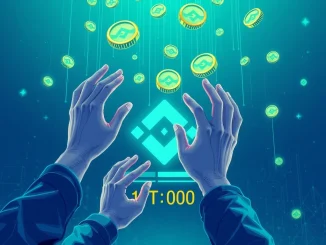
Are you an XRP holder watching the charts, wondering when to take profits? A provocative forecast from a pseudonymous analyst, @unknowDLT, suggests that a staggering 99% of XRP holders might make a critical error, selling their tokens between $10 and $20. This isn’t just about missing out on a few extra dollars; it’s about fundamentally misunderstanding XRP’s evolving role in the global financial system. This piece delves into the core arguments behind this bold prediction, exploring how institutional adoption and recent legal clarity are reshaping the narrative around XRP.
XRP’s Remarkable Evolution: Beyond Speculation
For years, XRP has been viewed primarily as a speculative altcoin, often mirroring Bitcoin’s volatile movements. However, a significant shift is underway. Analysts now argue that XRP is transitioning into a foundational layer for global finance, driven by tangible utility rather than mere market sentiment. This crucial change is at the heart of the latest XRP News, indicating a departure from its historical behavior.
What’s fueling this transformation?
- Ripple’s Strategic Partnerships: Ripple, the company behind XRP, has been busy forging alliances that embed XRP into real-world financial systems. A prime example is the collaboration with Ondo Finance, tokenizing U.S. Treasury securities on the XRP Ledger. This expands XRP’s utility far beyond simple cross-border payments, positioning it within the burgeoning institutional finance space.
- RLUSD Stablecoin: The approval and circulation of Ripple’s stablecoin, RLUSD, by New York’s financial regulators, further solidifies XRP’s integration into established payment networks. This move signals regulatory acceptance and expands its reach within traditional financial infrastructures.
These developments highlight a deliberate strategy to move XRP from a speculative asset to a critical infrastructure component. The growing institutional adoption is a key factor that many early sellers might be overlooking.
Legal Clarity: A Game Changer for XRP Price Trajectory
Perhaps the most significant catalyst for XRP’s re-evaluation has been its journey through the legal system. The landmark ruling in 2023 by Judge Analisa Torres, declaring that XRP is not a security in programmatic sales, sent shockwaves through the crypto world. This decision had immediate and profound implications:
- CME Futures Launch: The ruling directly paved the way for the launch of XRP futures on the Chicago Mercantile Exchange (CME). This is a monumental step, placing XRP alongside Bitcoin and Ethereum in the derivatives market, a domain traditionally reserved for major, regulated assets.
- Attracting Institutional Investors: With regulatory uncertainty largely cleared, institutional investors, who typically shy away from ambiguous assets, have found a new comfort level with XRP. This influx of sophisticated capital is reducing XRP’s historical correlation with Bitcoin’s price swings, allowing it to gain independently.
The newfound legal clarity is not just a footnote; it’s a fundamental shift that underpins the asset’s appeal to central banks, cross-border payment firms, and tokenization ecosystems. It suggests that the future XRP Price will be increasingly driven by utility and large-scale adoption, rather than speculative retail sentiment.
The Decoupling Debate: Is XRP Truly Different?
Historically, the crypto market has moved in lockstep with Bitcoin. When Bitcoin sneezes, altcoins catch a cold. However, the narrative around XRP is increasingly challenging this norm. The idea of XRP ‘decoupling’ from Bitcoin has gained significant traction, fueled by its unique regulatory status and specific use cases.
Prominent crypto figures like Crypto X AiMan and Edoardo Farina have echoed @unknowDLT’s warnings, cautioning against premature selling. AiMan suggests that 99% of holders risk “selling too early,” while Farina famously called selling at $10 “the biggest mistake of your life.” These sentiments reflect a strong belief that XRP’s true value is still unrealized, with current price levels merely a temporary floor before a significant breakout. This ongoing debate is a central theme in recent XRP News and market discussions.
The core argument is that while a bear market might temporarily suppress XRP’s price, its underlying infrastructure projects and growing institutional adoption could insulate it from broader crypto market downturns. This contrasts sharply with traditional altcoin behavior, where most assets lose significant value during bear cycles.
The $10-$20 Trap: Why It Might Be a Psychological Barrier
The $10-$20 price range has become a psychological focal point for many XRP holders, often viewed as a prime target for profit-taking. However, analysts argue that this level could be a ‘trap’ – a point where premature selling undermines potential long-term gains. The current valuation, while seemingly modest, is a confluence of powerful tailwinds:
- Legal Validation: The clear regulatory status reduces risk for large investors.
- Real-World Utility: Partnerships like Ondo Finance and the RLUSD stablecoin demonstrate tangible use cases.
- Growing Liquidity: Expanding liquidity hubs and interest from major financial players are creating deeper markets.
These factors suggest that the future XRP Price could defy conventional expectations, driven by its systemic importance rather than short-term market sentiment. The analyst’s warning emphasizes that most holders might not grasp the full implications of XRP becoming a cornerstone of the next financial era.
Actionable Insights for XRP Holders:
Given these insights, what should XRP holders consider?
- Re-evaluate Price Targets: Consider if your current profit-taking targets account for XRP’s evolving utility and institutional interest.
- Stay Informed: Keep a close eye on Ripple’s partnerships, regulatory developments, and broader trends in tokenization and cross-border payments.
- Long-Term vs. Short-Term: Differentiate between short-term speculative movements and the long-term vision of XRP as a critical financial infrastructure.
- Diversification: While optimism is high, remember that all investments carry risk. Diversification remains a prudent strategy.
Conclusion: A New Era for XRP?
The debate surrounding XRP’s future is intense, but the argument for its potential decoupling from Bitcoin and its rise “without ever stopping” is gaining significant ground. The analyst’s warning serves as a powerful reminder: XRP is not just another altcoin. Its unique position, bolstered by significant legal clarity and accelerating institutional adoption through Ripple’s strategic moves, positions it as a potential cornerstone of the emerging financial system.
Whether this vision materializes fully depends on sustained adoption, continued regulatory stability, and the ability to maintain strong institutional interest. For now, the question of whether holders will recognize XRP’s true power before selling too early keeps the cryptocurrency community on edge, making every piece of XRP News critically important.
Frequently Asked Questions (FAQs)
Q1: Why are analysts warning against selling XRP between $10-$20?
Analysts like @unknowDLT believe that selling XRP in this price range overlooks its long-term potential as a foundational component of the new financial system. They argue that factors like institutional adoption, legal clarity, and real-world utility will drive its value far beyond these levels, making early selling a missed opportunity for significant gains.
Q2: How does legal clarity impact XRP’s value?
The 2023 ruling that XRP is not a security for programmatic sales significantly reduced regulatory uncertainty. This clarity has attracted institutional investors, led to the launch of XRP futures on the CME, and positioned XRP more favorably in the broader financial market, thereby boosting its appeal and potential for price appreciation.
Q3: What role does institutional adoption play in XRP’s future?
Institutional adoption is seen as a key driver for XRP’s long-term value. Partnerships like Ripple’s collaboration with Ondo Finance to tokenize U.S. Treasury securities and the circulation of the RLUSD stablecoin are embedding XRP into traditional financial systems. This shifts XRP from a speculative asset to a critical infrastructure layer, reducing its reliance on retail sentiment and making its price trajectory more stable and utility-driven.
Q4: Can XRP truly ‘decouple’ from Bitcoin’s price movements?
The debate over XRP’s decoupling from Bitcoin is intensifying. While altcoins historically mirror Bitcoin’s volatility, XRP’s unique regulatory status and specific use cases (like cross-border payments and tokenization) are creating divergence. Analysts suggest that its fundamental utility and institutional interest could allow it to gain independently, even during broader market downturns.
Q5: What are the key partnerships contributing to XRP’s utility?
Key partnerships include Ripple’s collaboration with Ondo Finance for tokenizing U.S. Treasury securities on the XRP Ledger, which expands its utility in institutional settings. Additionally, the approval and circulation of Ripple’s stablecoin, RLUSD, by New York regulators, further embeds XRP into real-world financial systems and payment networks.



